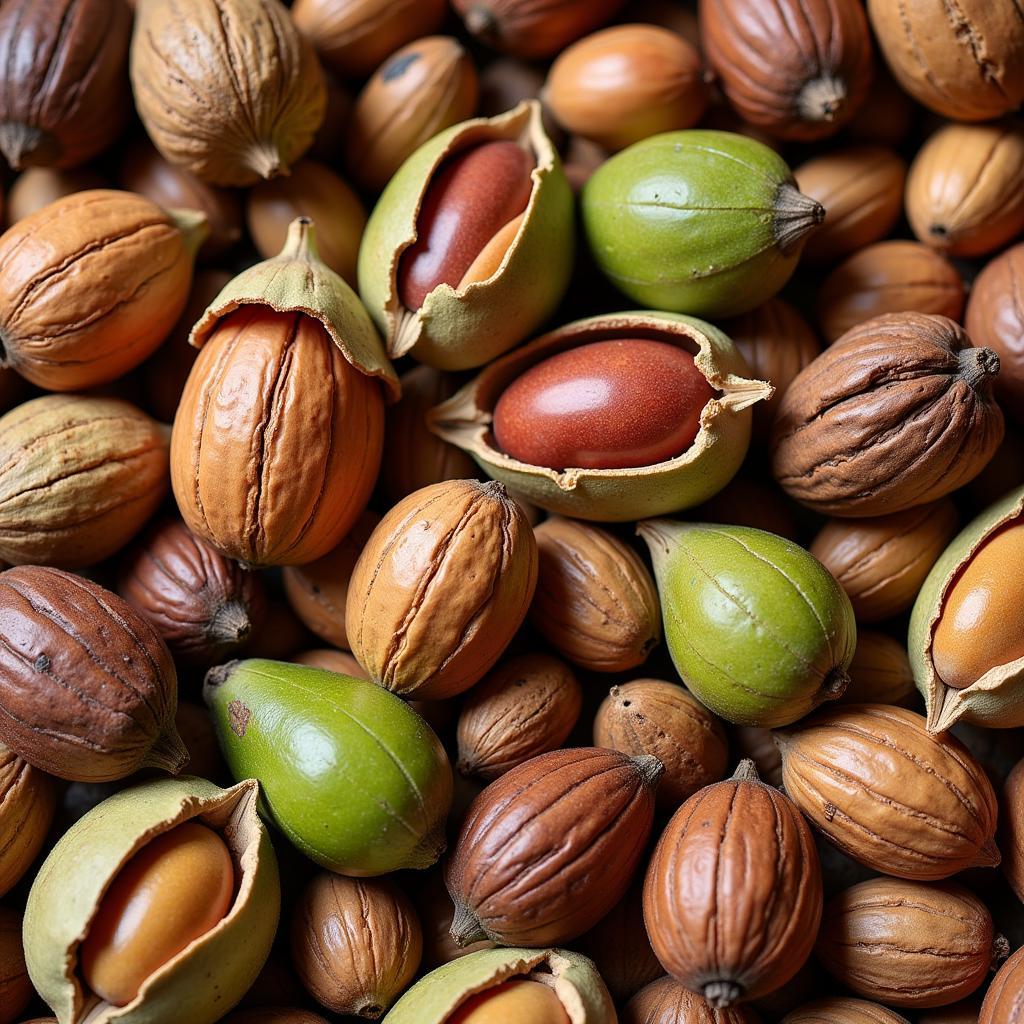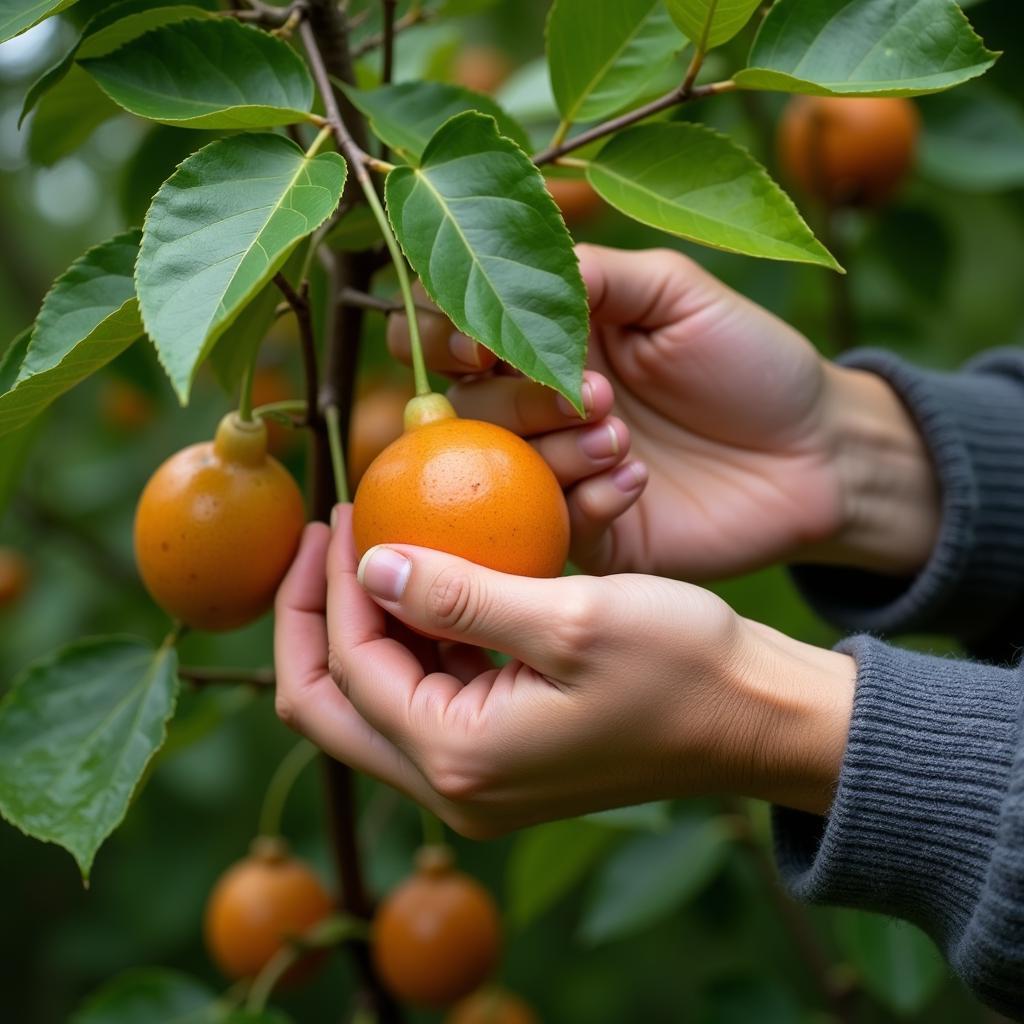When we think of Food From Trees, our minds often jump to the obvious: fruits. But the world of edible treasures trees provide extends far beyond the sweet and juicy. From nuts and seeds to leaves and bark, trees offer a diverse and delicious pantry for those who know where to look.
Beyond the Orchard: Unveiling the Hidden Harvest
 Assortment of Nuts and Seeds from Trees
Assortment of Nuts and Seeds from Trees
While fruits might be the showiest offerings from trees, nuts and seeds are the nutritional powerhouses. Almonds, walnuts, cashews, and pecans, with their healthy fats, protein, and fiber, are excellent sources of sustained energy and essential nutrients. These make for fantastic snacks, salad toppers, or ingredients in both sweet and savory dishes. Let’s not forget the humble but mighty seed. Think cocoa beans, the foundation of our beloved chocolate, or coffee beans, fueling our mornings.
From Leaves to Bark: Uncommon Delights from the Forest
Venturing beyond the familiar, we discover a world of culinary possibilities in the leaves and bark of certain trees. Take, for instance, the tender leaves of the moringa tree, packed with vitamins and antioxidants, or the subtle sweetness of maple tree sap, transformed into delicious syrup. Even tree bark, often overlooked, offers culinary and medicinal benefits. The cinnamon we sprinkle on our lattes is a prime example, harvested from the bark of the cinnamon tree.
Foraging with Care: Respecting Nature’s Bounty
 Hands Carefully Harvesting Food from Trees
Hands Carefully Harvesting Food from Trees
As with all things from nature, responsible harvesting is crucial. Over-foraging can deplete resources and harm the delicate balance of our ecosystems. When foraging for food from trees, it’s essential to:
- Properly identify: Ensure you’ve accurately identified the tree and its edible parts. Some species have poisonous look-alikes.
- Take only what you need: Harvest in moderation, leaving enough for the tree to regenerate and for wildlife to enjoy.
- Be mindful of the environment: Avoid damaging the tree or its surroundings.
Bringing the Flavors Home: Incorporating Tree-Based Foods
Incorporating food from trees into your diet doesn’t have to be complicated. Here are a few simple ideas:
- Snack Smart: Keep a stash of your favorite nuts and seeds on hand for a quick and healthy snack.
- Salad Power-Up: Add crunch and flavor to salads with toasted nuts, dried fruits, or even edible flowers.
- Spice Up Your Life: Experiment with spices derived from trees, like cinnamon, nutmeg, or allspice, to elevate your culinary creations.
- Get Creative with Beverages: Brew a pot of herbal tea using leaves from trees like birch or linden, or indulge in a cup of hot cocoa, a treat derived from the cacao tree.
From the familiar comfort of a crisp apple to the exotic allure of cinnamon bark, the world of food from trees offers a diverse and delicious array of options for every palate. So, next time you’re seeking culinary inspiration, look no further than your nearest tree – you might be surprised by the bounty you discover.
FAQs About Food From Trees
1. Are all fruits and nuts that grow on trees safe to eat?
No, not all fruits and nuts that grow on trees are safe for human consumption. Some trees may bear fruits or nuts that are toxic to humans. Always properly identify any plant before consuming it and consult reliable sources for information.
2. What are some common food allergies related to tree nuts?
Common tree nut allergies include almonds, walnuts, pecans, cashews, pistachios, and Brazil nuts. If you have a known allergy, always read food labels carefully and inform restaurants of your allergy when dining out.
3. Can I grow my own food-bearing trees?
Yes, many food-bearing trees can be grown at home, depending on your climate and growing conditions. Fruit trees like apple, pear, and citrus are popular choices for home gardens, as are nut trees like almond and pecan.
4. What are some sustainable ways to harvest food from trees?
Sustainable harvesting practices include taking only what you need, using proper pruning techniques to avoid damaging the tree, and leaving enough for the tree to regenerate and for wildlife to enjoy.
5. Where can I learn more about foraging for food from trees?
Local foraging groups, botanical gardens, and nature centers are great resources for learning more about foraging. You can also find a wealth of information in books and online resources.
For those looking to explore long-term food solutions, incorporating a variety of options is key. For instance, you might consider a 30-day food supply for a family of 4 that includes shelf-stable pantry staples alongside your foraged finds.
Whether you’re a seasoned forager or just beginning to explore the world of food from trees, remember to approach nature with respect and gratitude, and always prioritize safety and sustainability in your culinary adventures. And if you’re seeking high-quality, freeze-dried foods in bulk, we encourage you to explore our selection at Mina Cones Food. We’re committed to providing delicious and nutritious options for every need.
Need help finding the perfect food solutions for your family? Contact us at:
Phone: 02437655121
Email: minacones@gmail.com
Address: 3PGH+8R9, ĐT70A, thôn Trung, Bắc Từ Liêm, Hà Nội, Việt Nam.
Our customer care team is available 24/7 to assist you.